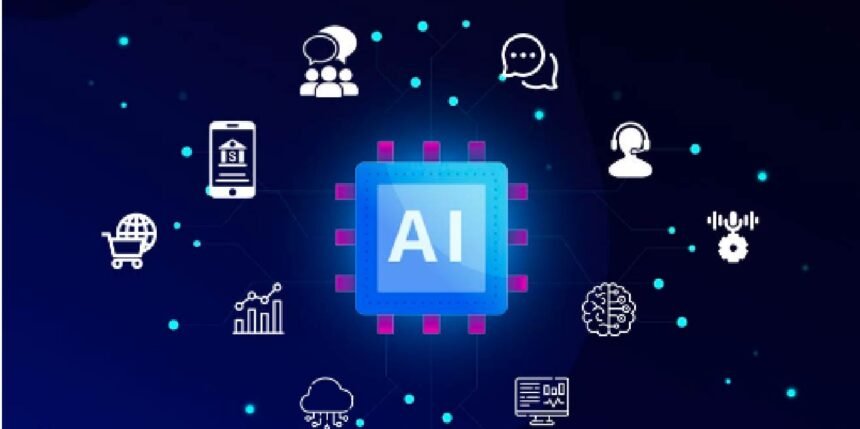The concept of artificial intelligence might appear to be a modern development. Organisations across different industries are currently implementing this technology. AI functions as an essential component in software development because it affects all stages from planning through designing to coding and testing. Artificial intelligence analyses vast amounts of information to identify trends, together with user preferences and possible security threats, within the design and planning phases.
AI can greatly improve code quality and productivity when it comes to coding. It provides intelligent code completion, error detection, and automatic code creation. One of the most significant modifications brought about by AI occurs during the testing process. AI tools for developers improve the quality assurance process by automating repetitive operations, running parallel tests, and evaluating test results quickly and correctly.
In this article, we explore the top AI-powered tools and how they help in enhancing productivity and code quality. So let’s first start by understanding AI testing tools.
Understanding AI tools
AI testing tools are advanced solutions that leverage artificial intelligence and machine learning to improve and automate various aspects of software testing. The testing tools utilise AI algorithms to boost both accuracy as well as coverage of testing activities while improving their efficiency. The main objective of AI testing involves workflow enhancement through automatic execution of tests and data validation operations, along with error identification procedures to evaluate software performance attributes.
By utilising AI tools, organisations can speed up their testing processes and improve software quality. These tools can be applied to specific parts of the testing process without needing to oversee the entire cycle. An easy illustration of an AI testing tool is the use of natural language processing for test scripting. In this scenario, developers can create test scripts using simple English, and the AI system is capable of comprehending, translating, and executing the provided instructions.
Top AI Tools for Developers
There are various AI tools that developers use to improve their testing efforts. Below are some top AI tools, each with a brief introduction, important functions, and their possible contributions to the testing process.
LambdaTest
LambdaTest is an AI-native test orchestration and execution platform to execute manual and automated tests at scale. The platform supports real-time and automated testing in over 3000 environments, including real mobile devices, browsers, and operating systems. LambdaTest provides advanced capabilities like auto-healing, flaky test detection, and various other AI-driven features for testing AI applications.
Developers can enhance software stability while accelerating their delivery of quality software through this practice. Its testing features cover functional testing, alongside performance testing and visual testing, which makes it ideal for organisations focused on delivering exceptional user experiences.
Key Capabilities:
- Self-Healing Tests: Automatically finds and fixes faulty test scripts when the UI changes, considerably decreasing testers’ maintenance effort.
- AI-Powered Test Data Generation: Realistic test data generation through dynamic processes enables the elimination of time-consuming manual test data configuration tasks. This increases the coverage and efficiency of test executions.
- Low-Code/No-Code Interface: Makes it simple for those with little technical knowledge to design, modify, and run automated tests. This is particularly useful for teams shifting from manual to automated testing.
- Efficient Test Scheduling and Monitoring: Tests can be planned and conducted at any stage of the development cycle. LambdaTest offers real-time monitoring, which allows testers to gain rapid insight into test performance.
Rainforest QA
Rainforest QA provides a complete solution for detecting user interface flaws and inconsistencies across several browsers and devices, including mobile and web applications. The tool makes use of a strong visual AI engine that functions like human vision to inspect displays for defects that standard functional testing or human testers might miss.
Furthermore, Rainforest QA intelligently filters out variations that are not regarded as defects, resulting in accurate outcomes. This intelligent automated testing technique improves accuracy, reduces errors made by humans, and allows for faster discovery of visual issues.
Key Capabilities:
- Visual Testing: Rainforest QA specialises in identifying UI problems, guaranteeing visual accuracy and uniformity in user experience.
- Test Automation Enhancement: Rainforest QA improves automated visual testing capabilities, permitting testers to identify visual errors quickly and efficiently.
- Cross-Browser and Cross-Device Testing: The tool supports tests that verify both platform and device functionality, allowing testers to check visual and operational aspects on a wide range of screen sizes.
PractiTest
PractiTest is a comprehensive test management platform. It enables organisations to take control of their testing operations and manage all testing artifacts, such as demands, tests, and defects, in a single hub. PractiTest reduces obstacles by integrating QA activity, strategies, teams, and technologies into a single platform, fostering consistent communication and establishing a single source of truth for testing operations.
PractiTest uses powerful machine learning techniques to bring cutting-edge AI-powered capabilities to QA teams. In addition, the tool developed Test Value Score, an innovative feature that evaluates and scores each test case, providing a measurable indication of its effect on the testing process.
Key Capabilities:
- Test Management from Start to Finish: Through its central management system, PractiTest enables organisations to handle requirements, tests and defects together, leading to better data-based choices and clear communication.
- Test Value Score: This special feature evaluates the impact of test cases, enabling organisations to concentrate on highly valuable tests and efficiently use their resources.
- Easy Test Step Generation & Optimisation: Testers can experience both time savings and achieve uniformity throughout test cases via the construction of test steps through the Smart Fox AI Assistant.
- Sturdy Integrations: Practitest’s integration with the widely used tools CircleCI, Jira, and Selenium simplifies productivity and teamwork functions.
FireFlink
FireFlink is a cutting-edge test automation tool that uses ML and AI to optimise the efficiency and efficacy of software testing. The platform is dedicated to improving the test automation process, expediting test generation, and increasing test coverage. FireFlink expands its capabilities to incorporate comprehensive API testing, allowing teams to perform end-to-end low-code API testing regardless of coding background.
Key Capabilities:
- Auto-Healing Tests: FireFlink automatically detects changes in the application under test and updates tests accordingly, reducing the need for manual intervention and improving test reliability over time.
- Intelligent Wait: FireFlink dynamically adjusts test execution based on real-time application behaviour, enhancing reliability and saving time.
- Visual Change Detection: FireFlink identifies and highlights visual differences between different versions of an application’s UI, enabling early detection of unintended changes.
Parasoft
Parasoft is a Generative AI-driven test automation platform that allows testers to develop end-to-end tests from the perspective of the end user to improve testing efficiency, accuracy, and scalability. The intelligent AI capabilities of Parasoft make it a prominent AI for test automation solution, which automatically generates and maintains test scripts. Testers can decrease their test case creation and maintenance workload because of this approach. The tool integrates easily with widespread CI/CD tools, together with issue-tracking systems, which enables direct integration into existing development processes.
Key Capabilities:
- No-Code Automated Test Creation: Manual testers can use Parasoft to develop tests through simple English language instructions.
- Supported Multiple Environments: The testing capabilities of Parasoft extend to testing across diverse environments that encompass desktop applications and web and mobile platforms.
- Integration with CI/CD Tools: The platform enables effortless integration with several popular CI/CD tools and issue-tracking systems, including CircleCI, Jenkins, Jira, along multiple others.
Significance of enhancing productivity and code quality
Improved dependability
High-quality code delivers enhanced dependability as its main benefit. Clean, well-structured code is less likely to include flaws and cause unforeseen problems. Software with applied testing techniques requires fewer debugging sessions, along with fewer emergency fixes, leading to more stable and reliable software outcomes.
Enhanced maintainability
Code is dynamic; it evolves. High-quality code is more understandable, making it easier to adapt and extend as requirements change. Developers may make upgrades without concern for accidentally creating new issues. This adaptability makes it an invaluable tool in the fast-paced world of software development.
Increased efficiency
Optimised code is more efficient. Fully structured code with proper implementation of best practices requires fewer system resources to produce faster execution of tasks.
This leads to faster time to respond, lower system needs, and, ultimately, a more cost-effective solution.
Cost Savings
While investing time and effort in producing high-quality code may appear to be a short-term cost, it is a wise long-term financial decision. High-quality code lowers the need for prolonged maintenance and expensive corrections in the future. It is a proactive technique that may save organisations a significant amount of money by reducing technical debt and continuing maintenance costs.
Enhanced user experience
Finally, all of the benefits of high-quality code lead to a better user experience. Software reliability combined with speed and lack of bugs provides benefits to end-users. Their confidence in the application rises, resulting in enhanced user satisfaction.
How AI Tools Help Developers Enhance Productivity and Code Quality
AI testing tools use machine learning algorithms and AI approaches to transform software testing methods. These tools improve testing productivity by automating case production, helping maintain scripts with self-healing qualities, and providing predictive analysis for bug detection.
Improved test automation and efficiency
AI testing tools increase the effectiveness of test automation by automatically generating test cases and maintaining test scripts. These tools in a cloud-based CRM system can evaluate user interactions and build relevant test cases, guaranteeing comprehensive test coverage without the need for manual intervention. This improvement of the testing process allows QA teams to focus on vital tasks, accelerating the software development lifecycle.
Improved test maintenance and self-healing capabilities
AI test automation tools can maintain test scripts using self-healing capabilities. When a cloud-based platform keeps being upgraded, AI-powered testing tools can automatically adjust to UI changes and update test scripts. This lowers the need for script maintenance manually, guaranteeing that automated tests remain accurate and dependable as the application evolves.
Predictive and path analysis for proactive detection of issues
AI testing tools perform well in predictive and path analysis. It helps in uncovering possible errors before they affect users. AI can analyse past data and the latest test results to anticipate areas that are expected to malfunction. This helps quality assurance teams concentrate their testing activities on high-risk areas, resulting in improved application stability and performance.
Visual testing and analytics for complete UI validation
Visual AI features in testing tools allow for comprehensive UI validation across multiple devices and screen sizes. This ensures that the user interface is consistent and proper, resulting in a smooth user experience across desktop and mobile browsers. These technologies’ visual test analytics provide comprehensive knowledge of user interface concerns, allowing for faster resolutions.
Continuous testing and seamless integration in CI/CD workflows
AI-powered testing tools are intended for integration into CI/CD pipelines to enable continuous testing. These technologies can enable automated tests to be run with each code change in a cloud-based resource planning system. This continuous testing strategy guarantees that any issues are identified and rectified early in the development process.
Conclusion
In conclusion, the development of AI in test automation tools and their integration into software testing processes provides great potential for organisations.. From AI-powered test automation platforms to advanced test management systems, these tools use natural language processing, machine learning, and other AI technologies to simplify testing workflows and enhance software quality.
In the coming decades, AI technologies are projected to continue to revolutionise the field of software testing, providing innovative opportunities. Organisations that embrace AI-powered technologies and integrate them into their workflows can speed up their testing processes, produce higher-quality software, and, ultimately, promote organisational success.







